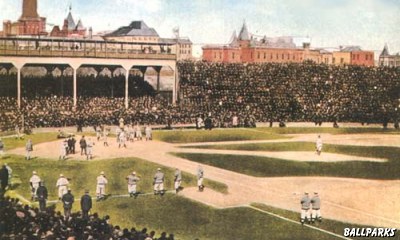Say it all once, a score of long years after.
Then, let it go at that..."
When baseball fanatics congregate, it takes about five minutes before the topic turns to, "Which team was the greatest?" Every true baseball fan has his or her nominee, though the list of nominees is not endless. In fact, it's rather short. Candidates include the vaunted '27 Yankees, a Yankee team from the '30's (Gehrig, DiMaggio, Dickey), or perhaps a Brooklyn team from the 1950's. Then, we have The Big Red Machine from the mid-1970's, the Athletics from the early '30's or the early '70's. Of course, there are the Yankees of the '50's and early '60's and perhaps you have your own dark horse or two.
One team is largely forgotten in this time-honored parlor game. It is a team, I will argue, that deserves to rank right up there with those '27 Yankees or '76 Reds.
It is sometimes difficult to compare teams from different eras. Today, when the batting crown goes to a .375 hitter, or the homerun laurels to a man who smacks 70 homeruns, statistics from other eras pale. It is sometimes difficult to see that Yaz's .305 average in 1968 led the league when today it will merely assure you a place on the team. No era suffers from this as much as the "Dead Ball Era". Those rough and tumble years before the Great War, before Ruth clobbered his 60 dingers.
There exists a team from the Dead Ball Era that deserves our recognition, our praise, our respect. Why?
Because it attained the best winning percentage ever; because on July 24th it had a record of 61 - 28; because by September 16th that record was 104 - 32 (that's right, just four losses in a month and a half); then, only four more losses the rest of the season. They ended with a 116-36 record, a winning percentage of .763.
They amassed this impressive record in a good league. And although the Pennant Race became something of a farce (the 2nd place team finished 20 games out of first place), two other teams finished with a winning percentage above .600.
And no, they didn't feed exclusively off the league's carrion. They built a 15-7 record against the second place team (who had a better record than the American League champion) and a 16-5 record against the third place team.
I am talking about, as any amateur baseball historian knows, the 1906 Chicago Cubs.
The Dead-Ball Era
First, some background on the Dead-Ball Era. Just how dead was the Dead-Ball Era? Pretty damn dead. I won't bore you with a ton of numbers, just a few.
In 1906, the National League hit .244. By way of comparison, in 1938, the National League hit .267. In 1906, all eight N.L. teams combined for a total of 126 home runs. In 1938, the New York Giants hit 125 home runs.
Still, what it lacked in the long ball and batting average it made up for in speed. The stolen base was part and parcel of the era's offensive tools. In 1906, the New York Giants led the league, swiping 288 bases. The Cubs rated second, with 283. In 1938, the entire National League stole 355 bases. The Dodgers led the league with 66.
Perhaps a better illustration of just how little hitting went on in the early years of the century are the pitching statistics. The Chicago Cubs pitching staff boasted a league-leading 1.76 ERA. Cubs pitchers allowed less than 2 runs per game: and they still lost 36 games. Brooklyn had the league's worst team ERA, 3.13. Contrast that with the N.L. of 1938. The lowest ERA was 3.37 (Chicago) and the worst ERA was 4.93 (Philadelphia).
So, in 1906, you have a game that relied heavily on singles, doubles and the stolen base. It must have been a rough and tumble game, especially for middle infielders.
The 1906 Chicago Cubs were an offensive and defensive monster. They led the league in batting average, hitting .266. They led the league in runs, with 705 (the number two team in runs scored 625). They were second in doubles, first in triples and second in home runs. They finished first in slugging average and second in stolen bases.
On the mound, they were equally, or maybe more, impressive. They boasted a league leading 1.76 ERA. They led the league in strikeouts. The pitching staff threw 125 Complete Games (unbelievably it was good enough for only third best) and led the league with 31 Shutouts.
Defensively, they committed the fewest errors in Major League baseball. And it wasn't even close. The Cubs committed 194 errors. The next best record was 228 errors, by the New York Giants. In the American League, Cleveland committed 216 errors, for the Junior League's best record.
Who were the 1906 Chicago Cubs?
1B-Frank Chance
2B-Johnny Evers
SS-Joe Tinker
3B-Harry Steinfeldt
C-Johnny Kling
RF-Frank Schulte
CF-Jimmy Sheckard
LF-Jimmy Slagle
P-Mordecai Brown
P-Eddie Reulbach
P-Jack Pfiester
P-Carl Lundgren
P-Jack Taylor
P-Orval Overall

The team played their home games at Chicago's West Side Grounds. The stadium held approximately 16,000 people. It was located about two miles west of downtown Chicago near present day South Wood Street, West Polk Street, South Lincoln Avenue and West Taylor Street.

In Part II, we'll discuss these players in more detail, the season they put together and some of their exploits on and off the field.

